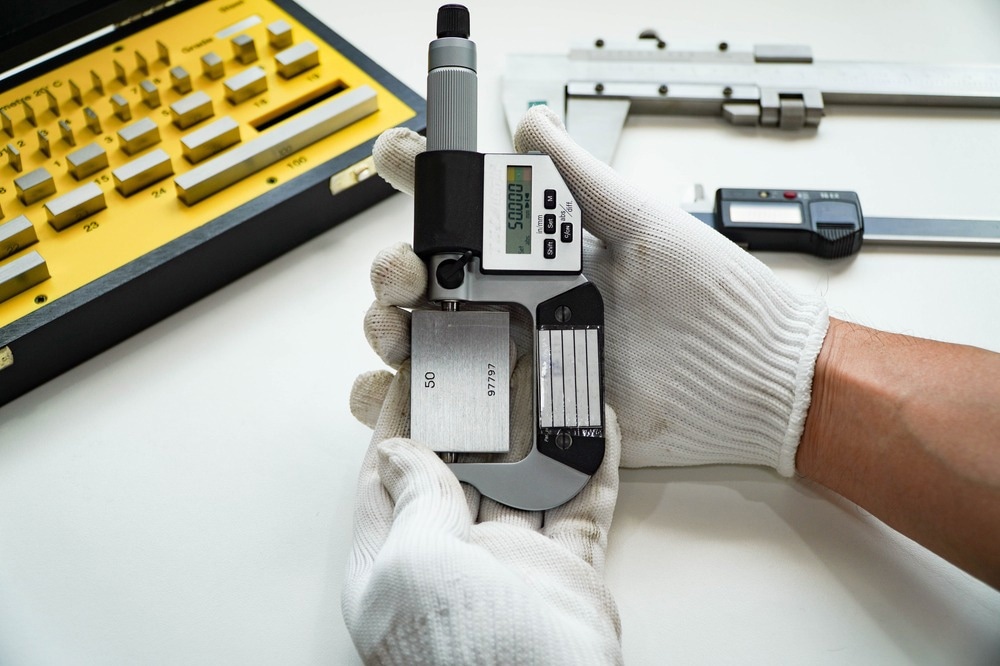In a world driven by data and precision, the concept of metrological traceability plays a pivotal role in upholding the integrity and reliability of measurements. Rooted in the principles of standardization, comparability, and accountability, metrological traceability serves as a cornerstone in fields ranging from scientific research to industrial manufacturing.

Image Credit: Rito Succeed/Shutterstock.com
This article delves into the significance of metrological traceability, its applications across various sectors, the challenges it poses, and its indispensable role in maintaining a coherent global measurement framework.
Metrological Traceability: What Does it Mean and Why It's Necessary
Metrological traceability is a property of a measurement result that refers to the ability to relate the result to a reference through a documented, unbroken chain of calibrations. This means that the measurement result can be traced back to a known standard, such as a national or international standard, with a high degree of confidence and accuracy.
Metrological traceability is essential for ensuring that measurements made at different times, by different analysts, and in different places are comparable. Without traceability, there is no way to know if a measurement made in one location is comparable to a measurement made in another location.
However, it is important to note that different countries may have different reference standards, which can lead to differences in measurement results. This is why international standards, such as those established by the International Organization for Standardization (ISO), are important for ensuring consistency and comparability of measurements across different countries.
Metrological Traceability and The National Institute of Standards and Technology (NIST) Policy
The concept of metrological traceability has been developed over many years, and the National Institute of Standards and Technology (NIST) has been a leader in this area. NIST has a longstanding commitment to traceability as a foundation stone in the reliability and overall quality of measurement.
The NIST has developed a policy on metrological traceability, which requires that there be an unbroken chain of calibrations that points to specified reference standards. This policy applies to all measurements made by NIST, as well as to NIST products and services.
Applications of Metrological Traceability Across Diverse Fields
The applications of metrological traceability span an array of domains, each emphasizing the need for consistency, accuracy, and reliability in measurements.
Healthcare and Pharmaceuticals: In the realm of healthcare, from diagnostic tests to pharmaceutical formulations, metrological traceability is paramount. Accurate measurements ensure proper patient care, dosage administration, and the effectiveness of medical interventions.
Manufacturing and Industry: In industrial sectors, such as automotive and aerospace, precise measurements are crucial for maintaining product quality and adhering to strict regulations. Metrological traceability guarantees that measurements of dimensions, tolerances, and weights are uniform and trustworthy.
Environmental Monitoring: From assessing air quality to monitoring water pollution, metrological traceability plays a crucial role in generating accurate environmental data. This data forms the basis for informed policies, interventions, and regulatory decisions to mitigate environmental impact.
Scientific Research: The pursuit of scientific knowledge relies on reproducibility and accuracy. Metrological traceability ensures that research findings are rooted in standardized measurements, enhancing the credibility and verifiability of results.
Trade and Commerce: In international trade, uniform measurements are essential for equitable transactions. Metrological traceability safeguards the interests of consumers and businesses alike by ensuring that quantities such as weight and volume are consistent across borders.
In legal matters and trade agreements, measurements often serve as the basis for decision-making. Traceability ensures that measurements can be defended in legal disputes and are honored in international trade negotiations.
Generally, for innovation and progress, discoveries and technological advancements are underpinned by accurate measurements. Metrological traceability fuels innovation by providing a foundation of reliable data that researchers can build upon.
Conclusion
Metrological traceability is a crucial aspect of measurement quality and reliability. It ensures that measurements can be compared across different locations and times with a high degree of confidence and accuracy. NIST has been a leader in the development of metrological traceability and has established a policy that requires the establishment of an unbroken chain of calibrations to specified reference standards.
Metrological traceability transcends the realm of mere measurements, embodying the essence of scientific rigor and accountability. From laboratories to industries, its role in guaranteeing accurate and consistent measurements is indispensable. By connecting measurements to standardized reference points, metrological traceability not only upholds the integrity of data but also fosters a global community united by a common language of measurement.
While metrological traceability has significantly bolstered measurement accuracy and reliability, challenges persist. The rapid pace of technological advancement demands that traceability mechanisms adapt to accommodate emerging fields such as quantum computing and nanotechnology. Furthermore, harmonizing measurements across borders and industries requires continuous collaboration and coordination among international standards organizations.
As we delve deeper into a data-driven era, the principles of metrological traceability will remain as critical as ever, guiding us toward precision, comparability, and trust in the measurements that shape our world.
More from AZoM: Metrology for Soft Surfaces
References and Further Reading
McCarthy, J. (2023). Foundational PNT Profile: Applying the Cybersecurity Framework for the Responsible Use of Positioning, Navigation, and Timing (PNT) Services (No. NIST IR 8323r1). National Institute of Standards and Technology, Gaithersburg, MD. https://doi.org/10.6028/NIST.IR.8323r1
NIST. (2020). SI Traceability and Primary Standards. [Online]NIST. Url: https://www.nist.gov/mml/csd/organic-chemical-metrology/primary-focus-areas/fundamental-chemical-metrology/si (Accessed: 14.08.2023)
NIST. (2010). NIST Policy on Metrological Traceability [Online]. NIST. Url: https://www.nist.gov/calibrations/traceability (Accessed: 14.08.2023)
Possolo, A., Bruce, S.S., Watters, J., Robert L. (2021). Metrological traceability frequently asked questions and NIST policy (No. NIST TN 2156). National Institute of Standards and Technology (U.S.), Gaithersburg, MD. https://doi.org/10.6028/NIST.TN.2156
Disclaimer: The views expressed here are those of the author expressed in their private capacity and do not necessarily represent the views of AZoM.com Limited T/A AZoNetwork the owner and operator of this website. This disclaimer forms part of the Terms and conditions of use of this website.